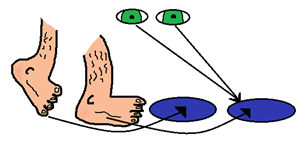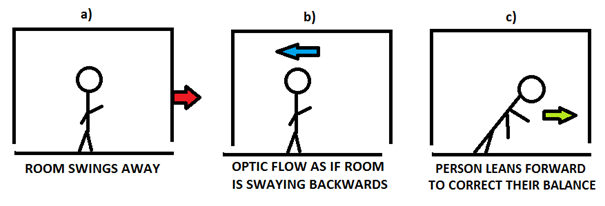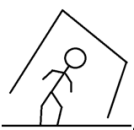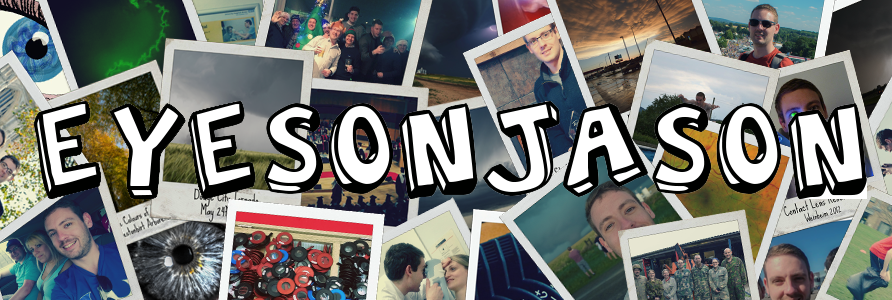Visual Guidance
Contents
Introduction
Humans and animals use their visual system to guide their movements. There are several key points to consider when using vision in guiding movement.
Exteroceptive Information:
This information is about the layout of the environment and movement within the environment. Vision provides a key role in providing the person with this form of information.
Proprioceptive Information:
This information is regarding the position of the body parts relative to one another. This information is mainly obtained from mechanical receptors in joints, the vestibular system and to some extent vision (i.e. you can see where certain body parts are).
Exproprioceptive Information:
This information is regarding the position of body parts in relation to the environment. Vision plays a key aspect in this form of vision.
Controlling Direction (Top)
Humans analyse their optic flow patterns in the process of controlling their direction. The focus of expansion is always centred upon the desired destination and the person could even reach their destination by keeping it on their focus of expansion.
This is simple when taking the linear route, but becomes much more complex when taking a rotational or curved path to the destination. Additionally, it is made more difficult still by not looking at the focus of expansion whilst travelling (i.e. looking around or looking at the floor).
Therefore to overcome this difficulty with the focus of expansion not always accessible via a linear route, the visual system will use the optic flow patterns instead to control direction. An example of this would be following the optic flow patterns of the road whilst travelling along it.
Furthermore, the visual system will use differential motion parallax (i.e. using different rates of optic flow of near and distance objects) to guide the route. Additionally, flow patterns may be relied upon more than the focus of expansion if the optic array contains more visual information than the focus of expansion.
Controlling Speed (Top)
From what has been discussed in the unit about optic flow, objects extend radially outwards and towards the periphery as we approach them. The rate of angular expansion is the rate at which an objects visual angle increases as we get closer to it. It is this rate of angular expansion that informs the visual system how fast it is moving.
When walking, humans rely upon the rate of angular expansion and proprioceptive information to judge speed. Driving, crossing roads and judging speeds or other motion judging tasks will require some element of learning.
Avoiding Objects and Collisions (Top)
The rate of angular expansion is also used to determine the "time of collision", which is used to determine when a person must change course or slow down. This time of collision is also used to calculate when to intercept or catch a moving object (such as in trying to catch a Frisbee or ball).
Differences Between Adults and Children
Infants have an innate flinching mechanism when faced with patterns of optic flow that suggest a collision course. Adults don't show this flinching mechanism if they are aware that there is no danger, unless they happen to be distracted (an example of this would be on a motion simulator, where collision optic flow exists but the adult inside is aware they are safe).
This shows that the detection and interpretation of optic flow patterns is present in babies and can be inhibited by conscious attention and awareness/knowledge of the surrounding environment.
Controlling Gait (Top)
Humans use visual cues to help them walk. When the foot hits the ground, it exerts horizontal force backwards against the ground and a vertical force upwards. These forces are demonstrated in the diagram with the stick figure.

The forces involved in walking
Our limb movements must be tailored to our terrain and visual information is required to anticipate this terrain. An example of this is when walking along a slippery surface (such as ice or a wet floor). These surfaces will require a small forces as larger forces will cause skidding. Conversely, more compliant surfaces such as mud or sand will require more force to overcome to maintain speed.

Your vision guides foot placement
The importance of vision in gait can be demonstrated by trying to cross a bumpy surface in the dark. Information is also required to guide foot placement when walking. When walking the visual system and brain is determining the placement of the next step whilst that foot is still on the ground and the other foot is in mid-swing
Hollands et al. (1995) found that the eyes saccade when the foot is on the ground to fixate on the place where the foot will next be placed.
Posture and Balance (Top)
Vision is a proprioceptive sense that is required for sensing location, orientation and balance, as well as the movement of the rest of the body. The balance aspect can easily be demonstrated by standing on one leg, where balancing is very easy when the eyes are open but extremely difficult when the eyes are closed. Humans automatically adjust their posture and balance in response to moving optic flow patterns.
Lee and Aronson (1974) performed experiments on balance using a swinging room. This is an experiment where the floor was stationary, but the patterned walls of the room were able to swing backwards and forwards. When the room swings away from the subject, the optic flow is similar to that if the person is falling backwards and as such the subject reacts to this by leaning forwards to compensate (in the figure below). The results of the experiment found that 33% of children actually fell flat on their faces when in the swinging room.

Lee and Aronson (1974) swinging room experiment demonstrating the posture and balance adjustments to optic flow.
The same sort of effect was found when the room swings towards the subject, making them feel as though they are falling forwards. This caused the subjects to start leaning back to correct for the perceived change in balance.
Children are much more responsive to optic flow patterns and this was seen by the percentage of children falling over in Lee and Aronson's 1974 experiment. Adults are much less responsive to the optic flow patterns and would only sway slightly in the swinging room. This indicates that the vestibular system and proprioception is relied upon much more than just the optic flow patterns for balance and posture. If the adults were forced to stand in an abnormal posture or had an inner-ear problem that may affect the vestibular system, then adults again react like children.

Trunk tilt to compensate the perceived room tilt.
Posture in a tilted room also causes some response to optic flow patterns. Adults running on a treadmill whilst a room unexpectedly begins to tilt (and thus cause optic flow changes as if the subject had turned their head in the opposite direction to the tilt), the subjects then tilted their trunk to compensate for the perceived tilt.
Children walking through a tilted room will also tilt their bodies to compensate for the changes in optic flow, so scientists are certain that optic flow information is used in maintaining posture.
Parietal Cortex Damage and Optic Ataxia (Top)
Cortical processing is also used in visual guidance and relies heavily on the parietal cortex. The parietal cortex receives it information from Area MST (optic flow) and IT (object recognition). Damage to the parietal cortex may result in optic ataxia.
Optic ataxia cause visually guided mis-reaching for objects. Subjects are still able to reach correctly when mechanical proprioceptive feedback is used (such as touching their own nose) but not when visual guidance is required (such as touching someone else's nose).
THIS CONCLUDES THE UNIT ON VISUAL GUIDANCE
RETURN TO TOP OF PAGE - UNIT 10: VISUAL ATTENTION, IMAGERY AND MEMORY
